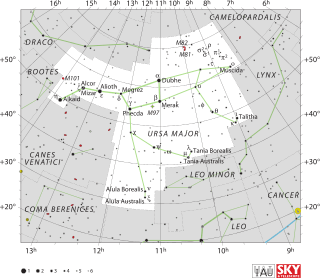Mu Ursae Majoris
 Location of μ Ursae Majoris (circled) | |
| Observation data Epoch J2000 Equinox J2000 | |
|---|---|
| Constellation | Ursa Major |
| Right ascension | 10h 22m 19.73976s[1] |
| Declination | +41° 29′ 58.2691″[1] |
| Apparent magnitude (V) | +3.06[2] |
| Characteristics | |
| Spectral type | M0 IIIab[2] |
| U−B color index | +1.90[3] |
| B−V color index | +1.59[3] |
| Astrometry | |
| Radial velocity (Rv) | –21.30 ± 1.66[4] km/s |
| Proper motion (μ) | RA: –81.47[1] mas/yr Dec.: +35.34[1] mas/yr |
| Parallax (π) | 14.16 ± 0.54[1] mas |
| Distance | 230 ± 9 ly (71 ± 3 pc) |
| Orbit[5] | |
| Period (P) | 230.089 days |
| Semi-major axis (a) | .0028" |
| Eccentricity (e) | 0.061 |
| Inclination (i) | 13.6° |
| Periastron epoch (T) | 2425577.030 JD |
| Argument of periastron (ω) (secondary) | 236.4° |
| Semi-amplitude (K1) (primary) | 7.40 km/s |
| Details | |
| Radius | 75[6] R☉ |
| Luminosity | 977[6]–1,200[4] L☉ |
| Surface gravity (log g) | 1.0[4] cgs |
| Temperature | 3,899[4] K |
| Metallicity [Fe/H] | +0.00[7] dex |
| Rotational velocity (v sin i) | 7.5[4] km/s |
| Other designations | |
| Database references | |
| SIMBAD | data |
Mu Ursae Majoris (μ Ursae Majoris, abbreviated Mu UMa, μ UMa), also named Tania Australis,[8] is a binary star in the constellation of Ursa Major. An apparent visual magnitude of +3.06[2] places it among the brighter members of the constellation. Parallax measurements give an estimated distance of roughly 230 light-years (71 parsecs) from the Sun, with a margin of error of 4%.[1]
Stellar system
Mu Ursae Majoris is an evolved star that is currently in the red giant stage with a stellar classification of M0 IIIab.[2] It has expanded to 75[6] times the radius of the Sun whilst the outer atmosphere has cooled to an effective temperature of 3,899 K,[4] giving it the orange-red hued glow of an M-type star.[9] Estimates of the luminosity range from 977[6]–1,200[4] times that of the Sun. It is classified as a semiregular variable star and its brightness varies from magnitude 2.99m to 3.33m.
This is a spectroscopic binary star system with a companion a mere 0.2 AU from the primary, assuming a distance of 71 parsecs, with an orbital period of 230 days.[5]
Nomenclature
μ Ursae Majoris (Latinised to Mu Ursae Majoris) is the star's Bayer designation.
It bore the traditional names Tania (shared with Lambda Ursae Majoris) and Tania Australis. Tania comes from the Arabic phrase Al Fiḳrah al Thānia 'the Second Spring (of the Gazelle)'.[10] and Australis (originally australis[11]) is Latin for 'the south side'. In 2016, the International Astronomical Union organized a Working Group on Star Names (WGSN)[12] to catalog and standardize proper names for stars. The WGSN's first bulletin of July 2016[13] included a table of the first two batches of names approved by the WGSN; which included Tania Australis for this star.
In Chinese, 三台 (Sān Tái), meaning Three Steps, refers to an asterism consisting of Mu Ursae Majoris, Iota Ursae Majoris, Kappa Ursae Majoris, Lambda Ursae Majoris, Nu Ursae Majoris and Xi Ursae Majoris. Consequently, Mu Ursae Majoris itself is known as 三台四 (Sān Tái sì, English: the Fourth Star of Three Steps) and 中台二 (Zhōng Tái èr, English: Star of Second Middle Step).[14]
References
- 1 2 3 4 5 6 van Leeuwen, Floor (November 2007), "Validation of the new Hipparcos reduction", Astronomy and Astrophysics, 474 (2): 653–664, arXiv:0708.1752v1
 , Bibcode:2007A&A...474..653V, doi:10.1051/0004-6361:20078357 Note: see VizieR catalogue I/311.
, Bibcode:2007A&A...474..653V, doi:10.1051/0004-6361:20078357 Note: see VizieR catalogue I/311. - 1 2 3 4 Mallik, Sushma V. (December 1999), "Lithium abundance and mass", Astronomy and Astrophysics, 352: 495–507, Bibcode:1999A&A...352..495M
- 1 2 Johnson, H. L.; et al. (1966). "UBVRIJKL photometry of the bright stars". Communications of the Lunar and Planetary Laboratory. 4 (99): 99. Bibcode:1966CoLPL...4...99J.
- 1 2 3 4 5 6 7 Massarotti, Alessandro; et al. (January 2008), "Rotational and Radial Velocities for a Sample of 761 HIPPARCOS Giants and the Role of Binarity", The Astronomical Journal, 135 (1): 209–231, Bibcode:2008AJ....135..209M, doi:10.1088/0004-6256/135/1/209
- 1 2 Ren, Shulin; Fu, Yanning (2013). "Hipparcos Photocentric Orbits of 72 Single-lined Spectroscopic Binaries". The Astronomical Journal. 145 (3): 81. Bibcode:2013AJ....145...81R. doi:10.1088/0004-6256/145/3/81.
- 1 2 3 4 Jorissen, A.; et al. (May 2009), "Spectroscopic binaries among Hipparcos M giants. III. The eccentricity - period diagram and mass-transfer signatures", Astronomy and Astrophysics, 498 (2): 489–500, arXiv:0901.0938
 , Bibcode:2009A&A...498..489J, doi:10.1051/0004-6361/200810703
, Bibcode:2009A&A...498..489J, doi:10.1051/0004-6361/200810703 - ↑ Mallik, Sushma V. (October 1998), "Chromospheric activity in cool stars and the lithium abundance", Astronomy and Astrophysics, 338: 623–636, Bibcode:1998A&A...338..623M
- ↑ "IAU Catalog of Star Names". Retrieved 28 July 2016.
- ↑ "The Colour of Stars", Australia Telescope, Outreach and Education, Commonwealth Scientific and Industrial Research Organisation, December 21, 2004, retrieved 2012-01-16
- ↑ Richard Hinckley Allen. "Star Names — Their Lore and Meaning - Ursa Major, the Greater Bear". Retrieved 2016-08-26.
- ↑ Piazzi, G. (1814), The Palermo Catalogue, Palermo
- ↑ "IAU Working Group on Star Names (WGSN)". Retrieved 22 May 2016.
- ↑ "Bulletin of the IAU Working Group on Star Names, No. 1" (PDF). Retrieved 28 July 2016.
- ↑ "(Activities of Exhibition and Education in Astronomy) 天文教育資訊網 2006 年 6 月 21 日" (in Chinese). Retrieved 2016-08-26.